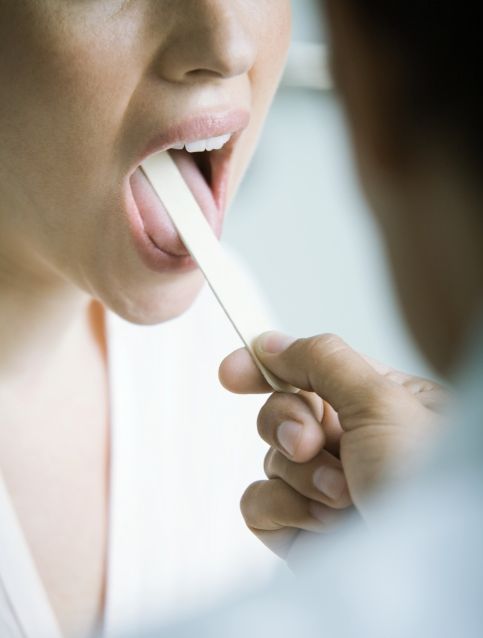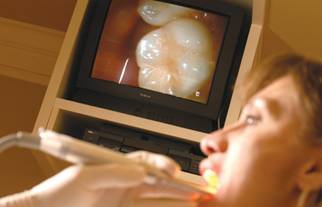CLEANINGS & PREVENTION
Dental Exam
A comprehensive dental exam will be performed by your dentist at your initial dental
visit. At regular check-up exams, your dentist and hygienist will include
the following:
- Examination of diagnostic x-rays (radiographs): Essential for detection of decay, tumors, cysts, and bone loss. X-rays also help determine tooth and root positions.
- Oral cancer screening: Check the face, neck, lips, tongue, throat,
tissues, and gums for any signs of oral cancer.
- Gum disease evaluation: Check the gums and bone around the teeth
for any signs of periodontal disease.
- Examination of tooth decay: All tooth surfaces will be checked
for decay with special dental instruments.
- Examination of existing restorations: Check current fillings, crowns,
etc.
Professional Dental Cleaning
Professional dental cleanings (dental prophylaxis) are usually performed by Registered
Dental Hygienists. Your cleaning appointment will include a dental exam and
the following:
- Removal of calculus (tartar): Calculus is hardened plaque that has been left on the tooth for some time and is now firmly attached to the tooth surface. Calculus forms above and below the gum line and can only be removed with special dental instruments.
- Removal of plaque: Plaque is a sticky, almost invisible film that
forms on the teeth. It is a growing colony of living bacteria, food debris,
and saliva. The bacteria produce toxins (poisons) that inflame the gums.
This inflammation is the start of periodontal disease!
- Teeth polishing: Remove stain and plaque that is not otherwise
removed during tooth brushing and scaling.
Fluoride is the most effective agent available to help prevent tooth decay.
It is a mineral that is naturally present in varying amounts in almost all foods
and water supplies. The benefits of fluoride have been well known for over
50 years and are supported by many health and professional organizations.
Fluoride works in two ways:
Topical fluoride strengthens the teeth once they have
erupted by seeping into the outer surface of the tooth enamel, making the teeth
more resistant to decay. We gain topical fluoride by using fluoride containing
dental products such as toothpaste, mouth rinses, and gels. Dentists and dental
hygienists generally recommend that children have a professional application of
fluoride twice a year during dental check-ups.
Systemic fluoride strengthens the teeth that have erupted
as well as those that are developing under the gums. We gain systemic fluoride
from most foods and our community water supplies. It is also available as
a supplement in drop or gel form and can be prescribed by your dentist or physician.
Generally, fluoride drops are recommended for infants, and tablets are best suited
for children up through the teen years. It is very important to monitor the
amounts of fluoride a child ingests. If too much fluoride is consumed while
the teeth are developing, a condition called fluorosis (white spots on the teeth)
may result.
Although most people receive fluoride from food and water, sometimes it is not enough
to help prevent decay. Your dentist or dental hygienist may recommend the
use of home and/or professional fluoride treatments for the following reasons:
- Deep pits and fissures on the chewing surfaces of teeth.
- Exposed and sensitive root surfaces.
- Fair to poor oral hygiene habits.
- Frequent sugar and carbohydrate intake.
- Inadequate exposure to fluorides.
- Inadequate saliva flow due to medical conditions, medical treatments or
medications.
- Recent history of dental decay.
Remember, fluoride alone will not prevent tooth decay! It is important to brush at least twice a day, floss regularly, eat balanced meals, reduce sugary snacks, and visit your dentist on a regular basis.
A sealant is a thin, plastic coating applied to the chewing surface of molars, premolars
and any deep grooves (called pits and fissures) of teeth. More than 75% of
dental decay begins in these deep grooves. Teeth with these conditions are
hard to clean and are very susceptible to decay. A sealant protects the tooth
by sealing deep grooves, creating a smooth, easy to clean surface.
Sealants can protect teeth from decay for many years, but need to be checked for
wear and chipping at regular dental visits.
Reasons for sealants:
- Children and teenagers – As soon as the six-year molars (the first permanent back teeth) appear or any time throughout the cavity prone years of 6-16.
- Adults – Tooth surfaces without decay that have deep grooves
or depressions.
- Baby teeth – Occasionally done if teeth have deep grooves
or depressions and child is cavity prone.
What do sealants involve?
Sealants are easily applied by your dentist or dental hygienist and the process
takes only a couple of minutes per tooth.
The teeth to be sealed are thoroughly cleaned and then surrounded with cotton to
keep the area dry. A special solution is applied to the enamel surface to
help the sealant bond to the teeth. The teeth are then rinsed and dried.
Sealant material is carefully painted onto the enamel surface to cover the deep
grooves or depressions. Depending on the type of sealant used, the material
will either harden automatically or with a special curing light.
Proper home care, a balanced diet, and regular dental visits will aid in the life of your new sealants.

Many people think of tobacco use as the primary cause for oral cancer but there are many more causes. Alcohol consumption, a diet low in fruits and vegetables, and even the sun, are causes of oral cancer. In fact, this form of cancer accounts for about 2% of cancers in women and 3% of cancers in men. According to the American Cancer Society, it is one of the few cancers for which the death rate has actually increased.
Don’t let this often-painless cancer creep up on you. If you experience any unusual swelling, redness or discoloration in your mouth, if you have any difficulty swallowing or feel that something is caught in your throat or if you have a persistent, unilateral earache, even if the way your teeth fit together has changed, please give us a call. Oral cancer is more common than almost any other cancer and the signs and symptoms can be subtle.

Have you ever wondered what your dentist was talking about when he tried to discuss
your oral health with you? Have you ever wished you could see what was going on
in there for yourself?
We just made dental care a lot more approachable and easy to understand, while making
early diagnosis accurate and reliable. Intra-oral cameras have greatly improved
the way we examine our patients’ teeth. Using a pen-sized camera, we
take video of your teeth and project the live image onto a television screen in
the treatment room. This image is magnified, allowing us to better see and detect
any decay, cracked or leaking fillings or other problems.
And even better, this vivid image is right there for you to see too. We can point out areas of concern and discuss treatment options with your full knowledge and understanding of the situation. Our patients love it!
A beautiful, healthy smile that lasts a lifetime is our ultimate goal when treating
patients. Your personal home care plays an important role in achieving
that goal. Your personal home care starts by eating balanced meals,
reducing the number of snacks you eat, and correctly using the various dental aids
that help control the plaque and bacteria that cause dental disease.
Tooth brushing – Brush your teeth at least twice a day (especially
before going to bed at night) with an ADA approved soft bristle brush and toothpaste.
- Place the brush at a 45 degree angle to the gums and gently brush using a small, circular motion, ensuring that you always feel the bristles on the gums.
- Brush the outer, inner, and biting surfaces of each tooth.
- Use the tip of the brush to clean the inside of the front teeth.
- Brush your tongue to remove bacteria and freshen your breath.
Electric toothbrushes are also recommended. They are easy to use and can remove
plaque efficiently. Simply place the bristles of the electric brush on your
gums and teeth and allow the brush to do its job, several teeth at a time.
Flossing – Daily flossing is the best way to clean between
the teeth and under the gumline. Flossing not only helps clean these spaces,
it disrupts plaque colonies from building up, preventing damage to the gums, teeth,
and bone.
- Take 12-16 inches (30-40cm) of dental floss and wrap it around your middle fingers, leaving about 2 inches (5cm) of floss between the hands.
- Using your thumbs and forefingers to guide the floss, gently insert the floss between
teeth using a sawing motion.
- Curve the floss into a “C” shape around each tooth and under the gumline.
Gently move the floss up and down, cleaning the side of each tooth.
Floss holders are recommended if you have difficulty using conventional floss.
Rinsing – It is important to rinse your mouth with water
after brushing, and also after meals if you are unable to brush. If you are
using an over-the-counter product for rinsing, it’s a good idea to consult
with your dentist or dental hygienist on its appropriateness for you.
Use other dental aids as recommended by your dentist or dental hygienist: Interdental brushes, rubber tip stimulators, tongue cleaners, irrigation devices, fluoride, medicated rinses, etc., can all play a role in good dental home care.

